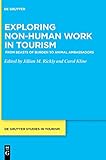Exploring non-human work in tourism : From beasts of burden to animal ambassadors / ed. by Carol Kline, Jillian M. Rickly.
Material type: TextSeries: De Gruyter Studies in Tourism ; 5Publisher: München ; Wien : De Gruyter Oldenbourg, [2021]Copyright date: ©2021Description: 1 online resource (VIII, 275 p.)Content type:
TextSeries: De Gruyter Studies in Tourism ; 5Publisher: München ; Wien : De Gruyter Oldenbourg, [2021]Copyright date: ©2021Description: 1 online resource (VIII, 275 p.)Content type: - 9783110659757
- 9783110660043
- 9783110664058
- G155.A1 E97 2021
- online - DeGruyter
- Issued also in print.
| Item type | Current library | Call number | URL | Status | Notes | Barcode | |
|---|---|---|---|---|---|---|---|
 eBook
eBook
|
Biblioteca "Angelicum" Pont. Univ. S.Tommaso d'Aquino Nuvola online | online - DeGruyter (Browse shelf(Opens below)) | Online access | Not for loan (Accesso limitato) | Accesso per gli utenti autorizzati / Access for authorized users | (dgr)9783110664058 |
Frontmatter -- Acknowledgements -- Contents -- 1 Introduction: Working for the (hu)man in the tourism industry -- Part 1: Theoretical considerations -- 2 Conceptualizing non-human animals as “workers” within the tourism industry -- 3 Redefining the work of working animals in the tourism industry: An animal-centric reflection -- Part 2: Performative work -- 4 Working donkeys in northwestern Mexico: Urban identity and tourism resources -- 5 Animal dark tourism in Mexico: Bulls performing their own slaughter -- 6 Farm animals’ participation in tourism experiences: A time for proper respect -- Part 3: Value-added work -- 7 Animals as tourism stakeholders: Huskies, reindeer, and horses working in Lapland -- 8 Distributed leadership in tourism experiences: Russian sled dogs and Icelandic horses leading the way -- 9 A working holiday: From home to destination with a guide dog -- 10 The donkeys of Santorini: Workers or slaves? -- 11 Monkey see, monkey do: The work of primates in Costa Rican sanctuaries -- 12 The greening of polar bears: Lively commodities in a climate change economy -- 13 “Cute, but get up and work!”: The biophilia hypothesis in tourists’ linguistic interactions with pandas -- Part 5: Reflections -- 14 Working animal research: An agenda for the future -- 15 Afterword: On tourism, animals, and suffering – lessons from Aeschylus’ Oresteia -- List of contributors -- List of figures -- Index
restricted access online access with authorization star
http://purl.org/coar/access_right/c_16ec
Critical animal studies is increasingly interfacing with tourism research in an effort to shed light on the various ways animals are incorporated into touristic experience. Exploring non-human work in tourism: From beasts of burden to animal ambassadors builds upon the theoretical connections of animal ethics, agency, and welfare as it foregrounds specifically the work that animals perform in the industry. While some types of animal labor are more readily identified, readers of this volume may be surprised by how many forms of animal labor are overlooked. Taking a widely international perspective, with cases from the Arctic, China, Costa Rica, China, Finland, Greece, Mexico, New Zealand, and the United Kingdom, this volume offers readers diverse scenarios of animals working. The book is arranged along three themes of work. Performative work focuses on the animals whose performances are front and center of tourists’ motivations and experiences. Value-added work turns attention to the co-working relationships of animals, while the political work of animals as ambassadors and icons is examined within the chapters on hidden labor. Additionally, the book makes theoretical considerations of the implications of positioning animals as workers and offers reflections on ways this focus on working animals extends current scholarship in the field.
Issued also in print.
Mode of access: Internet via World Wide Web.
In English.
Description based on online resource; title from PDF title page (publisher's Web site, viewed 28. Feb 2023)


